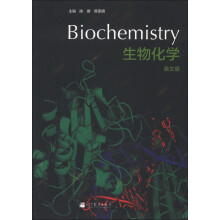生物化学(英文版)

目 录内容简介
Introduction
Chapter 1 Overview of Cell
1.1 Structural Organization of Prokaryotic Cells
1.2 Structural Organization of Eukaryotic Cells
Membrane
Cytoskeleton
The Nucleus
The Endoplasmic Reticulum and Golgi Apparatus
Mitochondria
Lysosomes and Peroxisomes
Key Words
Chapter 2 Protein
2.1 Amino Acids
General Structures of Amino Acids
Structures of the 20 Common Amino Acids
Spectroscopic Properties of Amino Acids
The Ninhydrin Reaction
Ionization of Amino Acids
2.2 Structures of Proteins
Peptide
Peptide Bonds
Primary Structure
Secondary Structure
Supersecondary Structure
Tertiary Structure
Quaternary Structure
The Classification of Proteins
2.3 Structure-function Relationships of Proteins
Primary Structure Determine the Conformation of Protein
Protein Denaturation and Renaturation
Protein Stability
Correlation between Conformation and Function of Protein
Protein Misfolding and Diseases
2.4 Protein Purification Techniques
Salting Out
Dialysis
Gel Filtration Chromatography
Ion Exchange Chromatography
Affinity Chromatography
Electrophoresis
SDS Polyacrylamide Gel Electrophoresis ( SDS-PAGE)
Isoelectric Focusing
Two Dimensional Electrophoresis
Ultracentrifugation
Key Words
Chapter 3 Enzymes
3.1 The History of Enzymes
3.2 Naming and Classification of Enzymes
EC 1 Oxidoreductases
EC 2 Transferases
EC 3 Hydrolases
EC 4 Lyases
EC 5 Isomerases
EC 6 Ligases
3.3 Structural Components of Enzymes
Apoenzymes,Cofactors and Holoenzymes
Active Center of Enzymes
Isozymes
3.4 The Properties of Enzymatic Catalysis
Enzymes Greatly Accelerate the Rates of Chemical Reactions
Specificity of Enzymes
Controllability of Enzyme Activity
3.5 Mechanism of Enzymatic Catalysis
Transition State and Activation Energy
Lock and Key Hypothesis
Induced Fit Hypothesis
Enzyme-Substrate Interactions
3.6 Enzyme Kinetics
Substrate Concentration Affects the Rate of Reactions
Michaelis-Menton Kinetics
The Significance of Km
Measurement of Km and Vmax
Enzyme Concentration Affects the Rate of Reactions
Temperature Affects the Rate of Reactions
pH Value Affects the Rate of Reactions
Inhibition of Enzyme Catalyzed Reactions
……
Chapter 4 Coenzymes and Vitamins
Chapter 5 Nucleic Acids
Chapter 6 DNA Replication
Chapter 7 RNA Synthesis-Transcription
Chapter 8 Protein Synthesis-Translation
Chapter 9 Regulation of Gene Expression
Chapter 10 Carbohydrate Metabolism
Chapter 11 Electron Transport and Oxidative Phosphorylation
Chapter 12 Lipid Metabolism
Chapter 13 Amino Acid Metabolism
Chapter 14 Nucleotides Metabolism
Chapter 15 Cell Signaling
Chapter 16 The Popular Techniques in Molecular Biology
Reference
Index
Chapter 1 Overview of Cell
1.1 Structural Organization of Prokaryotic Cells
1.2 Structural Organization of Eukaryotic Cells
Membrane
Cytoskeleton
The Nucleus
The Endoplasmic Reticulum and Golgi Apparatus
Mitochondria
Lysosomes and Peroxisomes
Key Words
Chapter 2 Protein
2.1 Amino Acids
General Structures of Amino Acids
Structures of the 20 Common Amino Acids
Spectroscopic Properties of Amino Acids
The Ninhydrin Reaction
Ionization of Amino Acids
2.2 Structures of Proteins
Peptide
Peptide Bonds
Primary Structure
Secondary Structure
Supersecondary Structure
Tertiary Structure
Quaternary Structure
The Classification of Proteins
2.3 Structure-function Relationships of Proteins
Primary Structure Determine the Conformation of Protein
Protein Denaturation and Renaturation
Protein Stability
Correlation between Conformation and Function of Protein
Protein Misfolding and Diseases
2.4 Protein Purification Techniques
Salting Out
Dialysis
Gel Filtration Chromatography
Ion Exchange Chromatography
Affinity Chromatography
Electrophoresis
SDS Polyacrylamide Gel Electrophoresis ( SDS-PAGE)
Isoelectric Focusing
Two Dimensional Electrophoresis
Ultracentrifugation
Key Words
Chapter 3 Enzymes
3.1 The History of Enzymes
3.2 Naming and Classification of Enzymes
EC 1 Oxidoreductases
EC 2 Transferases
EC 3 Hydrolases
EC 4 Lyases
EC 5 Isomerases
EC 6 Ligases
3.3 Structural Components of Enzymes
Apoenzymes,Cofactors and Holoenzymes
Active Center of Enzymes
Isozymes
3.4 The Properties of Enzymatic Catalysis
Enzymes Greatly Accelerate the Rates of Chemical Reactions
Specificity of Enzymes
Controllability of Enzyme Activity
3.5 Mechanism of Enzymatic Catalysis
Transition State and Activation Energy
Lock and Key Hypothesis
Induced Fit Hypothesis
Enzyme-Substrate Interactions
3.6 Enzyme Kinetics
Substrate Concentration Affects the Rate of Reactions
Michaelis-Menton Kinetics
The Significance of Km
Measurement of Km and Vmax
Enzyme Concentration Affects the Rate of Reactions
Temperature Affects the Rate of Reactions
pH Value Affects the Rate of Reactions
Inhibition of Enzyme Catalyzed Reactions
……
Chapter 4 Coenzymes and Vitamins
Chapter 5 Nucleic Acids
Chapter 6 DNA Replication
Chapter 7 RNA Synthesis-Transcription
Chapter 8 Protein Synthesis-Translation
Chapter 9 Regulation of Gene Expression
Chapter 10 Carbohydrate Metabolism
Chapter 11 Electron Transport and Oxidative Phosphorylation
Chapter 12 Lipid Metabolism
Chapter 13 Amino Acid Metabolism
Chapter 14 Nucleotides Metabolism
Chapter 15 Cell Signaling
Chapter 16 The Popular Techniques in Molecular Biology
Reference
Index
目 录内容简介
《生物化学(英文版)》在组织结构上,层次分明,重点突出;语言简明易懂;在内容上也结合多年教学经验,深入浅出,便于读者理解。同时也兼顾了临床医学及其他相关专业的需求。因此《生物化学(英文版)》可用作临床医学、口腔、公共卫生、医学检验、药学等专业双语教学用书,也可作为拟提高医学专业英文水平读者的工具书。
比价列表
暂无价格数据。
公众号、微信群
 缺书网
缺书网微信公众号
 扫码进群
扫码进群实时获取购书优惠

